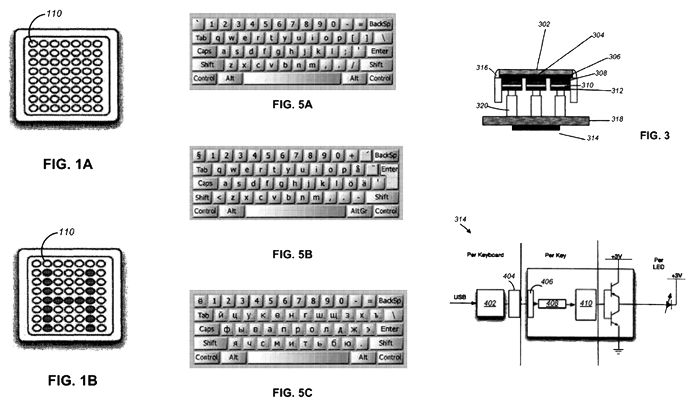Apple Inc. in a new patent filing proposes to solve the ages-old problem of having to manufacture distinct keyboards to support the various alphabets and key arrangements of foreign countries by developing an OLED-based model where key arrangements are altered on the fly by software.
"The most common physical arrangements of keys on keyboards in Western countries are based on the "QWERTY" layout (including closely related variants, such as the French "AZERTY" layout). However, in countries that do not use the Western alphabet, the keyboard layout is often very different," the Mac maker explained in the filing.
"Most computers allow a user can change the keyboard settings, or keyboard locale, for example, from a conventional QWERTY keyboard layout to a keyboard layout for the Cyrillic alphabet. Typically, there is an indication on the computer screen telling the user knows what keyboard locale is currently selected. However, nothing about the physical appearance of the keys themselves changes when a different locale is selected, so there is no way for a user to know what Cyrillic character will appear on the screen when a particular English key is depressed, unless the user has already memorized the locations of all the Cyrillic characters on the keyboard."
Furthermore, Apple said, many software applications makes extensive use of the various function keys on a computer keyboard, as well as the "Ctrl" and "Alt" keys, and various combinations thereof with the alphanumeric keys on the keyboard. As such, it is often difficult for a user to remember what operations the various function keys perform in different software applications, and what effect depressing a "Ctrl" or "Alt" key in combination with an alphanumeric character will have in various software applications.
"Therefore, in view of the above discussion, there is a need for a better way to indicate to a user what the effect will be of depressing a particular key or combination of keys on a peripheral device, such as a keyboard," the company wrote.
By way of Apple's invention, the altering key faces of the keyboard are accomplished by placing a number of organic light emitting diodes (OLEDs) on each key face, and using an application specific integrated circuit (ASIC) placed inside each key to turn on and turn off the respective diodes.
The respective ASICs would be controlled by signals originating from the software application in which the user is currently working and by the selected language locale. As a result, the users always have current and accurate information in front of them about what will happen when a particular key is depressed on the keyboard, and there is no need to memorize what actions particular key depressions will cause.
The March 13, 2007 patent filing is credited to Apple engineers Gavin Reid and Eric Smith.
 Prince McLean
Prince McLean







-m.jpg)






 Malcolm Owen
Malcolm Owen
 William Gallagher
William Gallagher
 Chip Loder
Chip Loder
 Brian Patterson
Brian Patterson
 Christine McKee
Christine McKee
 Wesley Hilliard
Wesley Hilliard
 Amber Neely
Amber Neely


-m.jpg)






73 Comments
This would be a godsend for gaming....
Wouldn't this be prohibitively expensive?
Great idea! Here's hoping we see it this year.
How does this patent differ from the Optimus Maximus keyboard from Art. Lebedev?
Ins't this reinventing the wheel? The Russians already have it on the market. Also, the extant version eliminates the cabling required by having the oleds on the keyboard base rather than in the keys. ~$462.27
http://www.artlebedev.com/everything/optimus/